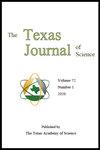DIET OF EIGHT SPECIES OF LIZARDS FROM GRANITE GAP, HIDALGO COUNTY, NEW MEXICO
Q4 Agricultural and Biological Sciences
引用次数: 1
Abstract
Granite Gap is a desert scrub habitat located in the Chihuahuan Desert in southwestern New Mexico about 200 km from the Texas border. In May 2016, we collected specimens of eight lizard species, six of which range into Texas: Callisaurus draconoides, Cophosaurus texanus, Uta stansburiana, Urosaurus ornatus, Gambelia wislizenii, and Aspidoscelis sonorae (a parthenogenetic species), plus two species not found in Texas: Sceloporus clarkii and Aspidoscelis tigris. We analyzed stomach contents of the preserved lizards and computed diet breadth and overlap for each. All lizard species consumed arthropods only. Considering the entire sample, there was a significant correlation between lizard snout-vent length (SVL) and total volume of arthropods consumed, and between lizard SVL and mean volume per prey item, but not between lizard SVL and number of arthropods consumed. This suggests larger lizards did not consume more arthropods than smaller lizards, but they did consume larger ones. Overall, A. sonorae was the most specialized lizard species at Granite Gap whereas C. texanus seemed to be the most generalized owing to its high numeric and high volumetric diet breadth. The dietary overlap data suggest there were two groups of lizards at Granite Gap: one that consumes a large number and volume of termites (Callisaurus, Cophosaurus, and the two species of Aspidoscelis) and the other that consumes a large number and volume of ants (Uta, Urosaurus, small Sceloporus) plus cicadas when lizard size is large enough to consume them (large Sceloporus and Gambelia).新墨西哥州伊达尔戈县花岗岩峡谷中八种蜥蜴的饮食
花岗岩峡是一个位于新墨西哥州西南部奇瓦瓦沙漠的沙漠灌木丛栖息地,距离德克萨斯州边境约200公里。2016年5月,我们采集了8种蜥蜴标本,其中6种分布在德克萨斯州,分别是:龙鳞龙(Callisaurus draconoides)、德克萨斯Cophosaurus texanus、Uta stansburiana、ornatus Urosaurus wislizenii、Aspidoscelis sonorae(一种孤雌生殖物种),以及2种在德克萨斯州未发现的物种:clkisceloporus和Aspidoscelis tigris。我们分析了保存下来的蜥蜴的胃内容物,并计算了每只蜥蜴的饮食宽度和重叠。所有种类的蜥蜴只吃节肢动物。从整个样本来看,蜥蜴的口鼻长度(SVL)与被捕食的节肢动物总量、平均每猎物体积之间存在显著相关,但与被捕食的节肢动物数量之间不存在显著相关。这表明较大的蜥蜴并不比较小的蜥蜴消耗更多的节肢动物,但它们确实消耗较大的节肢动物。总体而言,sonorae是花岗岩峡最特化的蜥蜴物种,而C. texanus由于其数量和体积的饮食宽度大,似乎是最普遍的。饮食重叠数据表明,花岗岩峡有两类蜥蜴:一类以大量白蚁为食(卡利龙、Cophosaurus和两种Aspidoscelis),另一类以大量蚂蚁为食(Uta、Urosaurus、小型Sceloporus),当蜥蜴体型足够大时,再加上蝉(大型Sceloporus和Gambelia)。
本文章由计算机程序翻译,如有差异,请以英文原文为准。
求助全文
约1分钟内获得全文
求助全文
来源期刊

The Texas Journal of Science
Agricultural and Biological Sciences-Ecology, Evolution, Behavior and Systematics
CiteScore
0.50
自引率
0.00%
发文量
2
期刊介绍:
Scholarly manuscripts reporting original research results in any field of science or technology, including science education, will be considered for publication in The Texas Journal of Science. Prior to acceptance, each manuscript will be reviewed by both knowledgeable peers and the editorial staff. Authors are encouraged to suggest the names and addresses of two potential reviewers to the Manuscript Editor at the time of submission of their manuscript.
 求助内容:
求助内容: 应助结果提醒方式:
应助结果提醒方式:


